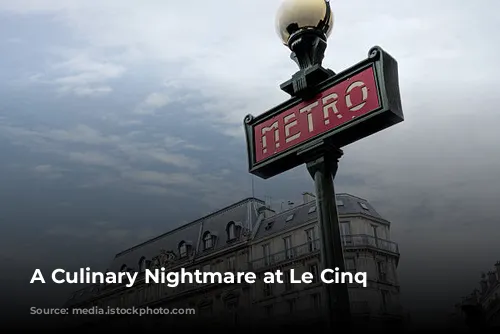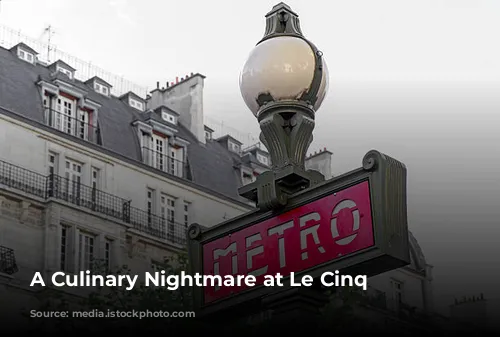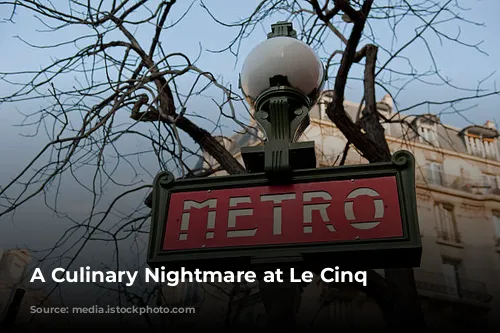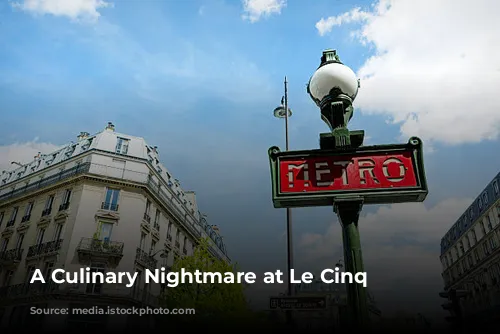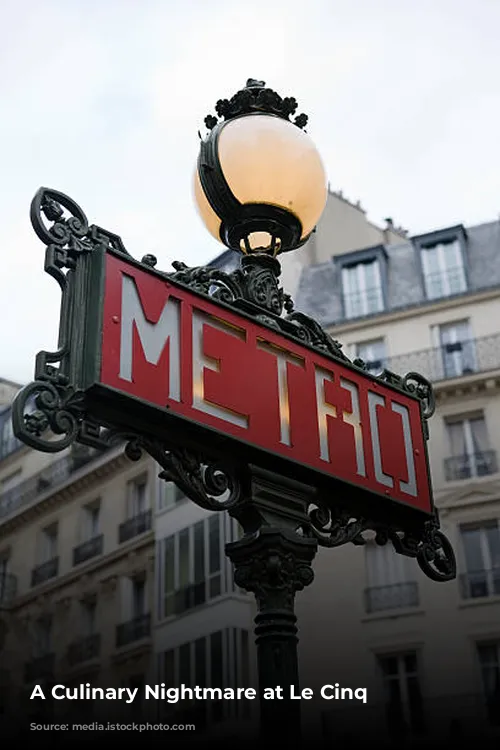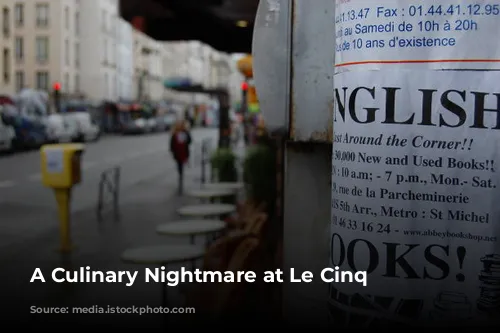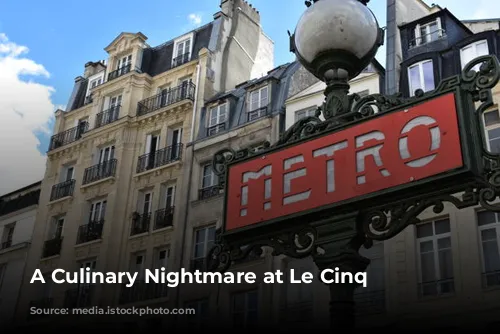Imagine this: you’re served a truly dreadful meal, but the waiters, bless their hearts, are oblivious to the culinary disaster unfolding before you. That’s exactly what happened to me at Le Cinq, the prestigious three-star Michelin restaurant within Paris’s renowned George V Hotel. I’ve been a food critic for 18 years, and let me tell you, Le Cinq delivered the most underwhelming and expensive dining experience I’ve ever encountered. It’s a feat in itself!
My initial intentions were far from negative. I was intrigued by reader complaints about the exorbitant cost of fine dining. I thought a visit to a classic Parisian restaurant like Le Cinq would provide a unique perspective – a glimpse into a world of luxury and extravagance. I envisioned an amusing observation, highlighting the absurdity of spending astronomical sums on food. In my mind, it would be a lighthearted commentary on the excesses of the wealthy. I chose Le Cinq, the brainchild of Chef Christian Le Squer, who was named “Chef of the Year” by his peers in 2016. I expected whimsy, perhaps even a touch of the outrageous. Little did I know that the abysmal quality of the food would leave me speechless.
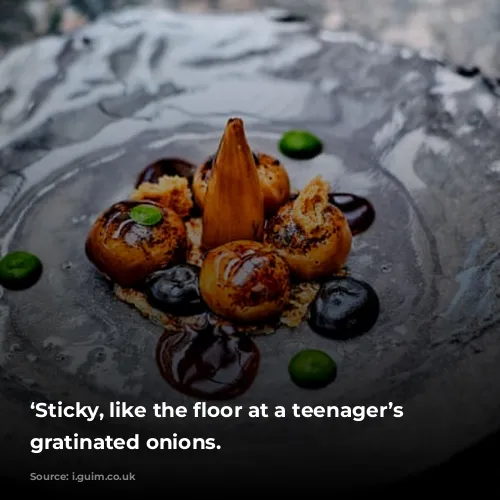
Opulence Meets Disappointment
The dining room, tucked away deep within the hotel, is a spacious area with towering ceilings and intricate moldings. The thick carpets absorb any sound, creating an eerily silent atmosphere. The color scheme is a blend of beige, cream, and a rather blatant “fuck you.” A smattering of gold accents remind us that this is a space designed for those who are unfamiliar with the concept of guilt. The room screams “money” with the same intensity that football fans yell at the referee. There’s even a stool for the lady’s handbag – of course, there is.
The menus, as tall as Richard Osman, are presented to us. My dining companion, who made the reservation, receives one without prices. The waiters seem bewildered when we protest, but they eventually provide one with the prices. After glancing at those figures, I understand why some people might wish they never saw them again. Starters and main courses are priced similarly, ranging from €70 to €140, which translates to roughly £121 for a single plate of food at the current exchange rate.
This lavish experience comes with canapés, amuse-bouches, pre-desserts, bread, and an air of superiority. Surprisingly, the most enjoyable elements are the pastries. The flaky brioche is a delightful treat best enjoyed with cool, salty butter. One of the canapés – a thin pastry filled with whipped chicken liver mousse topped with diced cornichons – is truly outstanding. I wouldn’t mind having that again. The meal concludes with some perfectly acceptable chocolates. At these prices, they better be.
Molecular Gastronomy Gone Wrong
Unfortunately, most of the other dishes were a culinary nightmare. The first canapé we were instructed to try was a transparent ball on a spoon. It resembled a Barbie-sized silicone breast implant and was a “spherification,” a gel globe using a technique perfected by Ferran Adrià at El Bulli around two decades ago. When we popped it in our mouths, it released stale air with a hint of ginger. My companion grimaced, “It’s like eating a condom that’s been left lying about in a dusty greengrocer’s,” she said. Spherifications of various forms – bursting, popping, deflating – appeared on many dishes. It seemed to be their signature move, their big idea. It was all they had. Another canapé, a tuile enclosing scallop mush, introduced us to the kitchen’s obsession with acidity. It wasn’t the bright, refreshing, aromatic acidity you’d get from, say, yuzu. This was a blunt, harsh acidity, the kind you’d use to polish dull brass coins.
We encountered this aggressive acidity again in an amuse-bouche that wasn’t really an amuse-bouche at all: a halved and refilled passionfruit, the tart passionfruit enhanced by a watercress purée that tasted only of the plant’s bitterest notes. My lips puckered, resembling a cat’s backside that’s brushed against stinging nettles.

Bland Dishes and Burnt Flavors
The most affordable starter was gratinated onions “in the Parisian style.” We were told it had the flavor of French onion soup. It made us long for a comforting bowl of French onion soup. The dish was mostly black, like a nightmare, and sticky, like the floor at a teenage party. There were bits of onion, but the dominant flavors were burnt and acrid, and spherified balls of onion purée that burst against the roof of the mouth with an unpleasant surprise. A dish of raw marinated scallops with sea urchin ice cream was a tidal wave of iodine. While it was the most innovative dish of the meal, it was hardly revolutionary. Sea urchin ice cream made its appearance on “Iron Chef America” back in the 1990s.
We ordered a pigeon main course, requesting medium-rare, but it arrived so pink that it could have taken flight again with a few volts of electricity. It was accompanied by aggressively acidic Japanese pear and more of that flavorless watercress purée. A mound of couscous was paired with a tiny portion of lamb for €95. Like the watercress purée, it lacked any real flavor. It was served with gummy purées, unpleasant spherifications of lamb stock, and mushy, one-note “merguez” sausages that were anything but. A sad, over-reduced sauce coagulated on the plate.
Dessert Disasters and a Disappointing Conclusion
A dessert of frozen chocolate mousse cigars wrapped in tuile was passable, if you ignored the elastic flap of milk skin draped over it, resembling something that had fallen off a burn victim. A cheesecake with lumps of frozen parsley powder was truly dreadful. I asked the waitress what the green stuff was. She told me and said brightly, “Isn’t it great!” “No,” I replied. “It’s one of the worst things I’ve ever eaten. It tastes of grass clippings.” Parsley is a wonderful addition to fish dishes, but in cheesecake? They removed it from the bill. With our mint tea, we were served a trendy kouign amann, a laminated, caramelized pastry. It was burnt around the edges.
We each enjoyed a glass of champagne, a glass of white wine, and a glass of red wine, all chosen for us by the sommelier from a wine list that included bottles priced at €15,000. The alcohol bill was €170, bringing the total to €600. Every single thing I ate at the restaurant Skosh for a sixth of the price was superior to this. It’s bizarre. The older gentlemen with their nieces who occupied the few other tables seemed unconcerned. The restaurant was never more than half full. People snapped photos of their plates. Mind you, I took pictures too, but mine were taken as if by a crime scene investigator, working methodically.
I’ve spent similar sums on dining experiences before and never regretted it. We each create our most cherished memories in different ways, and some of mine involve expensive restaurants. But they have to be good. This meal will stay with me, too. The memories are bleak and unsettling. With hard work and a bit of luck, maybe someday I’ll be able to forget.
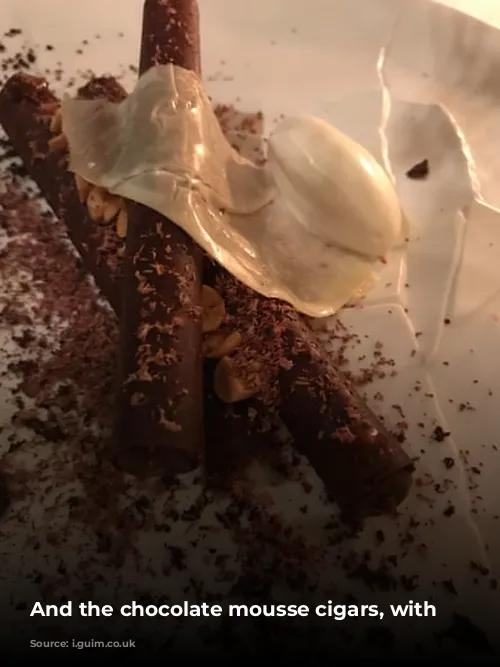
An Unforgettable Experience
Some readers may notice a discrepancy between my description of the onion dish – “mostly black, like nightmares” – and the photo above, which is golden and quite beautiful. Le Cinq wouldn’t allow us to photograph their food, as we usually do after a review, and insisted we use their press shots. This is highly unusual. However, I did manage to capture some images during the meal using my iPhone 7 in the available light. As you can see, these photos offer a clearer perspective. Additionally, Le Cinq only provided a limited selection of food images. I photographed most of the meal myself.
If you want to read more about this experience, you can visit my website, jayrayner.co.uk/news/.
